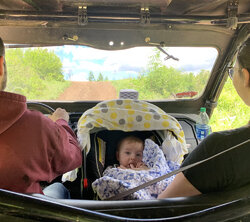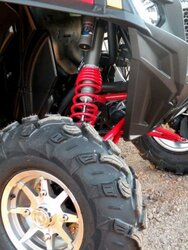
picture 1
There are many “marketing” rumors about
Dual Rate Spring (DRS) systems for the UTV market. Some true and some not. For this reason we feel it is important to understand how the system works and why. In a standard, single spring application (picture 1) there is one spring per shock. That spring has a single spring rate which is determined by the spring manufacturer when it was made. Different wire diameter as well as the number of coils per inch can affect the stiffness or spring rate. The spring rate is the force in pounds per EACH inch of compression the spring will exert. For instance, on a RZR 900 the front coil spring is approximately a 250 lb spring rate. This means that for each inch you compress the spring either by sitting in the car or landing from a jump the spring will give you 250 lbs of force for EACH inch it is compressed. Another way to look at it is if the spring is compressed 1 inch you will measure 250 lbs of force. If it is compressed 4 inches you will see 1000 lbs of force and if it is fully compressed, say 8 inches, you will see 2000 lbs of force. In this single spring and thus a single rate system, things are pretty simple and linear. If you lower the spring rate to a 200 lb spring you will feel a smoother ride with less chop and vibration because you are feeling 50 less pounds of force per inch on the frame and your butt as you drive over a rock or hole. The negative to a lighter spring is that when fully compressed ( 8 inches with a 200lb spring ) you only get 1600 lbs of force, per corner to help stop you from bottoming out. That is 1200 lbs less if you add up all four corners!
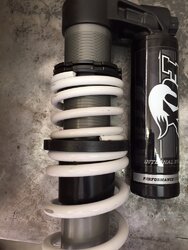
Pic 2,
dual spring system, NO cross over ring
In a Dual Spring (not dual rate) system ( picture 2 ) you have two springs on your shock that are separated by a plastic or nylon spring divider. The divider is designed to keep the springs in line as well as act as a bushing for the shock and keep the springs from rubbing on the shock body. The Dual Spring system is linear just like the single spring system is with one exception, it uses a COMBINED spring rate. If the shock were compressed one inch then BOTH of the springs would compress a little to add up to that inch. Also, since each springs rate is not added together the combined spring rate can be considerably lower than a single spring system. Lets take the 250 lb spring from earlier and use TWO 250 lb springs in this case. The formula for a dual spring system is as follows: top spring (TS) times bottom spring (BS) divided by the TS plus the BS. ( TS x BS ) divided by ( TS + BS ) Her is how that goes: ( 250 x 250 ) divided by ( 250 + 250 ) next (62,500) divided by (500) equals 125 lb combined spring rate. In this dual spring system you have a combined rate of 125 lbs per inch of compression. What? I know it doesn’t make sense that two 250 springs give you 125 lb spring rate but think of it like this, each spring compresses half of an inch (adding up to ONE inch total movement on the shock) which is 125 lbs of force PER SPRING. This force is TOTAL force. You do not add each spring’s force together to get the total, only the force it takes to compress the spring half of an inch. Still tough? That’s ok, just accept it. It is true. Below is a picture of a Dual Rate spring chart for you to use as a reference any time.
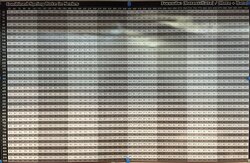
Now lets compress this Dual Spring system 8 inches. The total pressure exerted is 1000 lbs per shock. Remember you now have a combined spring rate of 125lbs per inch. You would most certainly bottom this system out in a medium hit. In order to get back to the same spring rate as a stock, single spring system you would have to use two 500 lb springs. (500 x 500) divided by (500 + 500) = 250 lb combined spring rate which is 2000 lbs when compressed 8 inches. Why bother running a Dual Spring system if it is the same linear rate as a single spring? Good question.
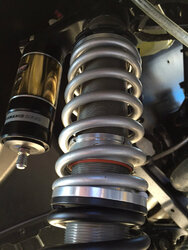
picture 3
Here is where it gets good.
In a true Dual Rate Spring system there are two springs and a spring divider just as before but you have one crucial extra item, a cross over ring. ( picture 3 ) Also known as a cross over nut, rate nut or secondary rate nut. This ring threads onto the shock body inside of the upper coil spring. It’s job is to contact the nylon spring divider where you set it. Once it contacts the spring divider, when the suspension is compressed, the upper coil spring is no longer used. The cross over ring has stopped the upper spring from compressing. Why is this good? Because, now you are only using the lower spring in your Dual Rate Spring system. Go back to our 250/250 example. Until the cross over ring hits the divider you are feeling a 125 lb combined spring rate which is plush but not enough spring to stop you from bottoming out. Once the upper spring is cancelled out by the cross over you are now feeling the Single lower spring rate of 250 lbs per inch! You just doubled your effective spring rate by going to a Single spring. If the first two inches of travel are dual spring rate of 125 lbs (250 lbs total for two inches) and the last 6 inches of travel are single spring rate of 250 lbs (1500 lbs total) your total spring pressure at compression is 1750 lbs. The cool thing about this set up is that your butt got to feel the soft, plush ride of a 125 lb rate for the first two inches of travel before you hit something big enough to compress past that and get into the 250 lb lower spring for the rest of the travel.
But wait, we are still missing 250 lbs of total pressure when fully compressed compared to the stock single spring. ( 1750 lbs versus 2000 lbs ). No problem. Lets run a 200 lb upper spring and a 300 lb lower spring. To figure the combined spring rate just (200 x 300) divided by (200 + 300) next (60,000) divided by (500) equals 120 lb combined spring rate. Now in this Dual Spring Rate system the first 2 inches of travel you are feeling 120 lb spring rate in your butt. Nice and plush. The last 6 inches of travel you feel a 300 lb single rate. Let’s add up the total pressure when compressed. 240 lbs for the first two inches, 1800 for the last 6 inches is a total of 2,040 lbs. There we go! Back to almost the same compressed force as the single, stock spring gave us but instead we get to enjoy the softer, smoother ride for the first 2 inches of tire movement at a 120 lb rate! This is the benefit of a Dual Rate Spring system.
THERE ARE ONLY TWO WAYS TO GET A TRUE DUAL RATE SPRING KIT, USE A CROSS OVER RING OR BIND THE UPPER SPRING!
If the upper spring is designed to go to bind (fully compress) during compression then when it binds you have taken it out of the system completely. This does the same thing as a cross over ring. When the upper spring is removed from the system you are now using the lower, heavier spring only. There are many negatives to this. First, you can not control when the spring goes to bind. If you add more weight to the car it will happen sooner. If you raise the ride height up it will happen later. There is no functional adjust ability to when the system gets stiffer. Second, when the spring binds it will show this by rubbing the powder coat off of the spring where it contacted each coil. This is the tell tail sign of a coil bound situation.
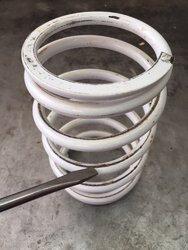
The factory RZR 1000 front and rear upper springs do this. The front happens way too late in the compression stroke and this is why the front is so soft and has a lot of nose dive under braking. The rear is at coil bind right at ride height. This means the rear is on the stiffer lower spring right away and why the rear has a tendency to buck and kit in the whoops and jumps since it is stiff too soon. Binding the upper spring is a cheaper way to create a dual rate spring system since you don’t have the cost of cross over rings but it needs to be designed perfectly. If not, it won’t work right. Also, if you do anything to the car (bolt on accessories, drive harder, add people) you will change when the spring binds and you can’t adjust or fix it. The second negative is that a coil bound spring tends to fail faster than a non bound spring. Case and point, factory upper front springs on the RZR 1000. Breakage of this spring is very common and the binding of this spring late in the travel is a big contributor to the issue. There are people who market their dual spring kits as dual rate because the upper spring goes to bind. Cool, just look at the upper spring powder coat and see if it really does.
There are Dual Rate spring kits on the market today that have never been sold with a cross over nut. They are not Dual Rate, only Dual Spring kits. We have seen them here and rated every spring on the car. On a RZR 900 they will often use a 250 lb lower spring with a short 1000 lb upper spring! Wow you say? Let’s do the math. (1000 x 250) divided by (1000 + 250) equals 200 lb LINEAR COMBINED SPRING RATE. This is lighter than the stock spring rate and would be more plush than stock but less total resistance when compressed. Remember without a cross over ring or coil bound upper spring this is still a single spring rate system. Even if this system had a cross over ring or a bound upper spring it would only change from a 200lb rate to a 250lb rate when the cross over was engaged. This is such a small spring rate jump for a secondary rate that it is all most not worth doing. Typical dual rate jumps are in the 100-300lb increase range. Another thing worth mentioning is that it is mathematically impossible to coil bind a 4″ tall, 1000lb spring with a 250lb lower spring on a RZR 900. Here is why. In order to bind this upper spring it would have to be compressed a little past 2 inches. This would require over 2000lbs of force to accomplish. Since the lower spring is 250lb rate this means it would have to be compressed over 8″ to get over 2000lbs of force. With a total shock travel of 8″ you could never get the required spring force to bind the upper spring. Remember that the upper spring will compress over an inch at some point which means the lower spring could never compress past 7″ in this spring set up. Even if it could bind it would happen way too late and have too small of a spring rate jump to be of any use. Remember, you can always check the powder coat on the upper spring and see if it actually binds.
Finally, we did not invent the Dual Rate Spring system that uses a cross over ring. It has been around for decades. Every competitive Trophy Truck, class one car and long travel sand car uses this system. Why do we market TRUE DUAL RATE spring kits with a cross over ring? Not to sell our cross over rings, that is for sure. You can buy your own cross over rings for any shock and use them too. You just have to pay a shock guy to put them on since they are not two piece. We market TRUE DUAL RATE spring kits because they are the best system you can run. From a spring stand point, it gives you the softest, most compliant and versatile ride quality possible over any and all terrain. We know from experience that this spring system combined with proper shock valving is the best possible system to run. Why doesn’t the factory run it on all their cars standard? Cost. Two springs with a divider and cross over are way more expensive than a single spring. Some accountant has done the math and figured they won’t sell enough units to justify the cost because most people just don’t know how great a good ride can become. You don’t have to take our word for it, just Google up a picture of every winner of every SCORE, BITD or LUCAS OIL race in the last 20 years and you will see a dual rate spring system with a cross over ring on it. Educate yourself and see how smooth things can be on your UTV!


